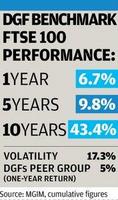In this week’s Investment Blueprint, Momentum’s Michael Allen says the three years of volatile equities prove the case for diversified growth funds (DGFs).
For many small-to-medium sized schemes (from £1m to £1bn), the potential to invest in a growth engine with less risk than equities has become extremely attractive.
 This has led diversified growth funds (DGFs) to become one of the most researched and fastest growing investment strategies in the UK.
This has led diversified growth funds (DGFs) to become one of the most researched and fastest growing investment strategies in the UK.
DGFs have all but replaced traditional balanced mandates and are becoming a core holding for UK-based retail and institutional investors alike.
Where balanced funds offer access to a blend of equities and bonds – typically with a 60/40 asset split – DGFs offer clients access to a broad range of asset classes and actively allocate between them to benefit from market opportunities.
In order for pension schemes to achieve their desired long-term capital growth, the avoidance of significant capital drawdown along the way remains a key concern for schemes and therefore the relationship of risk and return is crucial. DGFs offer a very sensible solution for this ongoing dilemma.
What is a DGF?
DGFs come in many guises but essentially offer clients an investment vehicle that targets equity-like returns with less risk over a full market cycle (i.e. five–seven years).
Typically, these funds can invest in a broad range of asset classes including equities, bonds and alternatives. Asset allocation is a core feature of the proposition and enables the fund managers to move between asset classes in order to benefit from market opportunities and construct a diversified portfolio of uncorrelated assets.
Diversified funds are typically managed with a capital preservation mindset, free of benchmark constraints and targeting returns over cash in the range of 3% net to 6% gross: the higher the return target, the higher the risk so the relationship between risk and return is a key indicator of how individual funds are managed.
How are schemes using these funds?
DGFs are typically being used as a core strategic holding within a portfolio and are combined with additional equities and bonds depending on the scheme’s desire for additional returns and liability management. For many schemes, they have replaced a portion or even all of the equity component of the existing strategy.
The nature of DGFs means they are equally relevant for defined benefit (DB) schemes (where the focus is on the overall management of the scheme’s funding status and risk tolerance) and defined contribution (DC) schemes where they are increasingly being implemented as the default choice.
The diversification benefits of investing in a range of asset classes through a single unitised structure now offers investors access to a strategy that was previously only available to the larger schemes and pension funds.
One of the key benefits of investing in a DGF is the cost-effective access to a broad range of uncorrelated asset classes in a liquid investment vehicle and the outsourcing of day to day decision-making such as the implementation of tactical asset allocation and ongoing governance and due diligence.
As DGFs are a relatively new investment proposition, it is difficult to assess them over a long term period as data is unavailable. However, these type of funds typically aim to provide equity like returns with less risk using a cash plus benchmark.
The past three years have been extremely volatile. The DGF peer group – including an extensive range of DGF funds used within the institutional marketplace – has delivered strong returns but with less volatility than equity markets, doing exactly what they are supposed to do.
So DGFs offer a sensible investment option for both DB and DC schemes, enabling participation in the upside of equity markets while managing the downside risk.
Michael Allen is chief investment officer at Momentum Global Investment Management.






















